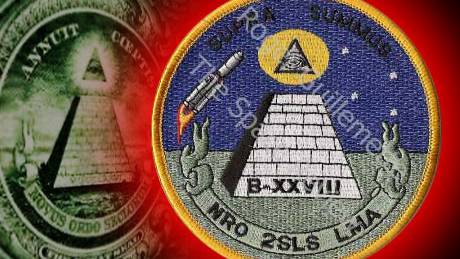Secrets and signs
Source: thespacereview.com
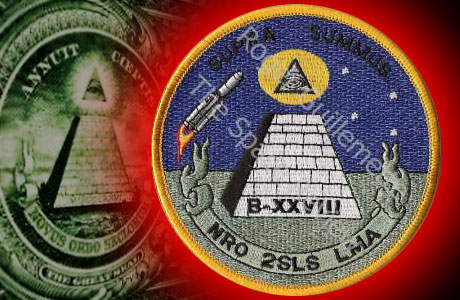
Patches for classified missions can sometimes provide otherwise-unavailable insights into the nature of those missions.
One of the biggest movies currently in theaters is National Treasure: Book of Secrets. Like its predecessor, the movie is a lot of silliness and ’splosions, a nonstop chase as the hero travels around the world to decipher clues leading to a city of gold underneath Mount Rushmore. Much of the plot hinges upon the Freemasons, a secretive society that has left symbols with mysterious meanings, and that some people believe actually controls the American government and even the entire world. One symbol commonly attributed to the Freemasons is the “all seeing eye”, or “eye of providence”, often depicted over a pyramid. This symbol appears in the movie and is even featured in the movie poster, but is most familiar to Americans because it is on the back of the one-dollar bill.
Those obsessed with Freemason conspiracy theories would probably go into orbit after learning that in 2000 the secretive National Reconnaissance Office (NRO) launched a satellite into space whose official mission patch featured a symbol nearly identical to the one on the dollar bill. While this was probably not a Freemason satellite, the “all-seeing eye” was undoubtedly intended to serve the same symbolic function as an observation satellite does in reality. (Ed Comment: To spy? Like the Information Awareness Office, with a "somewhat" similar logo?) More interesting to those obsessed with the NRO is the fact that the patch also features four stars hovering in the sky. Independent observers claimed that the classified satellite launched into orbit was actually the fourth of its type. Four stars. Four satellites.
Military patches and logos—simply the latest examples of heraldry dating back thousands of years—are by definition symbolic, so it is no surprise that they contain symbols. What is surprising is that these symbols often reveal information about the satellites’ identities and missions that are otherwise classified.
It turns out that this hidden symbolism in the patches produced for classified spacecraft launches is far more prevalent than previously believed. Although many official patches for classified missions do not offer any clues to their payloads, there are nearly two dozen mission logos, rocket launch patches, and/or accompanying payload patches that contain hints about the mission of a classified payload. The most common symbolism is a correlation between the number of stars in the patch and the number of satellites of that type launched into orbit over many years. Also common are Latin phrases referring to surveillance or watchfulness. But other features include indications of the satellites’ orbits, their construction, and even their tortured history to get off the ground. Although the first time that the media noticed this symbolism was in 2000, and to date only three examples have been reported in the press, the practice possibly dates as far back as 1977 and includes far more examples than anyone has previously recognized.
Fellowship of the dice
When an Atlas 5 rocket thundered aloft from its launch pad on Florida’s sunny coast on December 10, 2007, reporters knew that the sponsor of the launch—the agency that owned the payload—was the NRO. They also received updates about the launch’s progress right up through four and a half minutes into the flight, when the payload fairing separated. At that point, the Air Force stopped releasing progress reports to prevent disclosure of the spacecraft’s secret mission and orbital parameters. But although the NRO and the Air Force officially replied with a “no comment” to any questions about the payload, there was a glaringly blatant hint plastered on the side of the rocket’s nosecone. A big circular logo was affixed to the side of the payload fairing bearing the constellation name “Scorpius” and a graphical representation of the constellation. This was not that unusual: for nearly a decade now several NRO launches—but not the payloads themselves—have been named for constellations. The important hint was below the constellation.
Below the stars of Scorpio the logo featured an image of the Earth surrounded by three red satellite orbits. One of these circled the Earth at the equator, symbolizing a satellite in geosynchronous orbit, and the other two were in highly-elliptical, highly-inclined orbits, often referred to as HEO or, more traditionally, “Molniya” orbits after the early Soviet Union satellites that pioneered this path around the Earth. Those two types of orbits are occupied by a class of American communications data-relay satellites originally known by the name the Satellite Data System, or SDS, and that one source states was later named Quasar. Also painted on the logo was the Latin phrase Caveo Noster Morsus, which, loosely translated, means “I gather up our little bites”—a perfect description for the SDS mission.
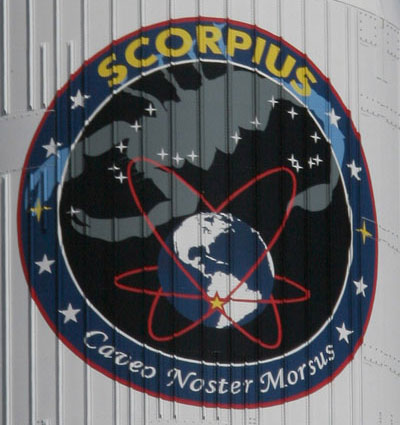
Ed Comment: A side note regarding the Scorpius Logo. It looks like the star, the crossing point of the three orbits are positioned around or above the area of Peru, South America. It might be of no significance, but for those who are familiar with Jay Weidner’s work on The Great Cross of Hendaye and the connection to Cuszo Peru, this becomes interesting.
Also check the phrase “Caveo Noster Morsus”. An alternative interpretations of this phrase/motto could be made if you check each word with a Latin Dictionary Caveo, Noster, Morsus.
It could mean: "To be on one's guard, to take care for or make safe (secure) the sting or bite of the Scorpion." If we consider that the Galactic Center is between Sagittarius and Scorpio it could be connected with the ”Alignement 2012” theory of John Major Jenkins.
With this big hint painted right there on the side of the nosecone, it was thus no surprise that the rocket lifted off its pad, and then headed northeast, in the same direction as previous satellites—including SDS satellites—launched into Molniya orbits. The Centaur’s ascent was observed along the Eastern Seaboard as far north as Quebec, and amateur satellite observers noted that the payload entered an initial parking orbit before being boosted to a much higher final orbit.
It turns out that another patch similar to this was produced some time ago, apparently for the launch of the seventh SDS satellite, placed into a Molniya orbit by a Titan 34D rocket in February 1987. That patch features the lettering “OD-4/DH” and the words “C’Mon Seven.” The “OD-4” stands for “Operating Division 4” of the Satellite Tracking Center that used to operate in the famous “blue cube” in Sunnyvale, California. The meaning of “DH” remains unknown. This indicates that the patch probably was not produced for a launch crew, but rather for an operations team involved with checking out the satellite after launch.
But there is another intriguing aspect to the patch. The two Molniya orbits are occupied by dice. The dice are apparently a reference to the drinking game “7 & 11”, and the SDS program apparently was originally known as Program 711.
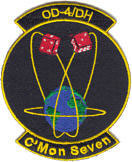
As the dice example illustrates, one challenge for determining what clues these patches might contain is that some of them are filled with arcane and “inside jokes” known only to those who worked on the program itself, or on the launch vehicle that placed the satellite in orbit. Some of the symbols really have nothing to do with the classified satellite program, but refer to events or incidents during preparation of the rocket on the pad. In fact, some of the patches are almost overtaken by little symbols and cartoons. Although one should be careful not to over-interpret the symbolism and become involved in a da Vinci Code-like search for symbols and meanings, because these patches and logos are intended to be symbolic, it is a safe practice to assume that every object they contain was put there for symbolic, and not artistic, purposes. The people designing these symbols have often exhibited a devilish sense of humor, practically daring outsiders to figure out what they are doing.
The golden compass
Occasionally the hints that the intelligence community uses in these logos and patches are both obvious and subtle. Take, for example, the launch last summer of a pair of ocean surveillance satellites.
On June 15, 2007, the NRO launched an Atlas 5 from Florida. Like the Scorpius launch, this one also had a logo on the side of the payload fairing. The logo depicted the constellation Pyxis, the compass—featuring a compass rose—and showed a satellite flying in a high inclination orbit around the Earth. The logo contained other more telling details. Most notably, it depicted a sailing ship, thereby hinting at a naval mission. But this was not simply a generic sailing ship image. The ship looks almost exactly like the ship on the official seal of the former Naval Security Group Activity in Denver, Colorado. This organization is now known as Navy Information Operations Command, and one of their jobs is tracking ships at sea. The logo also contained two stars on its edge. Amateur observers who track classified satellites with binoculars have noticed that for the past several years American satellites they suspect are used to track ships at sea travel in pairs.

The logo also contains some obscure bit of Latin: Non est ad astra mollis e terries via. It is a phrase from the philosopher Seneca the Younger that means “The trip from the Earth to the stars is not an easy one.” Unfortunately, this bit of Latin phrasing proved to be more prophetic than philosophical, because it was soon reported that the rocket’s upper stage had underperformed, placing the satellites in a lower orbit than planned.
The owls are not what they seem
Perhaps the most well-known example of a launch logo revealing the mission of a classified spacecraft occurred in 2000, with the August 17 launch of a Titan 4B from Vandenberg Air Force Base. The rocket was designated B-28. (Titan 4 mission nomenclature is somewhat confusing. Initially, all vehicles were labeled with the letter K designation; after the Upgraded Solid Rocket Motors were introduced, vehicles were designated either as A (original model) or B (SRMU equipped), yet a few of the later missions carried both designators, such as vehicle A-20 K-17 or B-41 K-30).
The NRO produced a patch for the launch that was depicted on the Florida Today newspaper’s Space Online website and quickly caught the attention of Canadian satellite watcher Ted Molczan. Molczan posted his suspicions about the patch to the space watcher list-serve See-Sat.org, and his comments soon came to the attention of the Washington Post, which published an article on the subject.
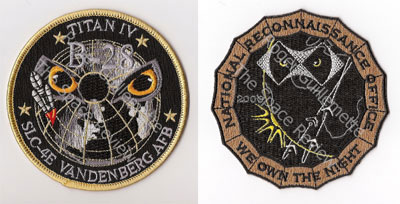
Molczan stated that he had suspected that the launch would be a new radar imaging satellite. Over the years such satellites have had the designations Lacrosse and Onyx. He also suspected that the launch would go to either a 57 or 68 degree inclination orbit, based upon previous Lacrosse launches.
Upon seeing the patch, Molczan noticed several things. First was that the patch depicted four wing-shaped symbols circling the Earth in two different orbits—analogous to the 57 and 68 degree orbits occupied by previous Lacrosse satellites. Of those four symbols, three were white and one was red. Molczan knew that of the four Lacrosse satellites launched to date, the first spacecraft, launched aboard the Space Shuttle in 1988, had been deorbited.
The patch also contained some other notable elements. A pair of owl eyes hovered at the top of the logo, and the eyes were surrounded by a mesh. Could this be a reference to the wire mesh dish of the Lacrosse spacecraft? At the bottom of the patch was the phrase “We Own The Night,” a reference both to the owl and likely to the fact that one of the strengths of military radar satellites is that they are unaffected by nighttime conditions.
Although this one patch contained a number of hints, it was actually one of three produced for the launch. A second patch is similar to the first. In addition to references to the rocket, as well as the launch pad and Vandenberg, it also includes the owl eyes and four stars, apparently symbolizing the four satellites. But it also depicts a polar view of the Earth covered with what could be either satellite orbits, or the spokes of a dish-shaped antenna.
A third patch developed for the launch was the “all-seeing eye” patch mentioned earlier. Although the eye over the pyramid symbol is often attributed to Freemasons, the symbolic eye itself can be traced back to ancient Egypt, and in the United States it was first included on the reverse side of the Great Seal of the United States in 1782. Clearly whoever developed the design for the patch took the symbol from the dollar bill and adapted it, intending it to symbolize the same thing as the owl eyes on the other two patches—the ability of the satellite to see regardless of day or night. The logo also contains the launch number B-28 written out in Roman numerals, and letters representing the NRO, the 2nd Space Launch Squadron, and Lockheed Martin Aerospace.
The fact that the NRO continued to produce logos like that for Pyxis and Scorpius seven years after the owl patch received a lot of attention in the press is a clear indication that this activity has the approval of NRO security. Perhaps more interesting is the fact that this was not the first time that a Lacrosse launch had contained a hint in the mission patch. Another patch that contains a key similarity was produced for Titan 4 K-18, which was launched on October 23, 1997 from Vandenberg. That patch also contains an owl’s head. That was the third Lacrosse launched into orbit. There are three stars on the patch. Three stars. Three satellites.
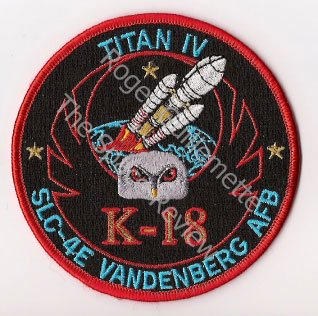
Enter the dragon
Whereas the owl patches demonstrate an obvious pattern, a more intriguing example of patterns in the launch patches is provided by the launches of Titan 4’s B-25 and B-36, and several similar patches that are apparently much older, and all of which contain images of dragons. This appears to be a clear indication that the dragon is a symbol for a class of high altitude signals intelligence satellites originally developed under the name Rhyolite.
On September 8, 2003 a Titan 4B launched from Cape Canaveral’s Complex 40 to place a satellite into geosynchronous orbit. The rocket was equipped with the largest payload shroud built for it, a 26.2-meter (86-foot) long monster that obviously concealed a massive satellite, which independent observers claimed was a signals intelligence satellite. Two patches were produced for this launch. One is rather jumbled. It depicts the silhouette of a B-36 Peacemaker bomber and the word “Peacemaker” at the top. It also depicts references to the Third Space Launch Squadron, Space and Missiles Command (SMC), the NRO, and Lockheed Martin Aerospace. The patch also features the Latin phrase Vos Intuebor, which means “to look at attentively,” or alternatively, “to gaze at, consider, to admire, contemplate, observe, or look upon.”
But far more intriguing is another patch developed for the launch. Unlike the first patch, this one is simple and abstract. It contains no letters or numbers of any kind, just the image of a dragon with the Earth in its talons. The dragon is holding a diamond with its tail. This patch probably symbolizes the rocket’s payload. But could a dragon somehow be symbolic for the program itself? Alternatively, could the diamond refer to the name of the program?
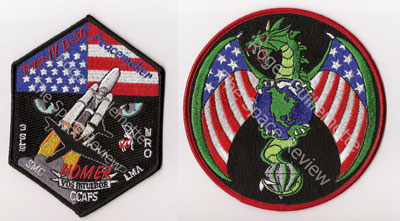
It turns out that this is not the first time that a launch patch has featured this symbolism. Five years earlier, on 8 May 1998, Titan 4B-25 launched from Cape Canaveral. Like B-36, the Titan also featured an 86-foot launch shroud and flew to geosynchronous orbit, and independent observers speculated that both launches carried similar signals intelligence satellite payloads.
Once again those involved in the launch produced two patches, apparently one for the launch team and another to symbolize the payload. The launch patch featured another Air Force bomber, this time the B-25, and also a rising sun logo, symbolizing the famous 1942 B-25 raid on Tokyo. The patch shared other similarities. The names “Jack” and “Walter” also appear on the patch, as does the phrase “You Don’t Know Jack.” It is common for Titan 4 rocket patches to carry two names on them, symbolizing the Titan rocket (in this case, “Jack”) and its Centaur upper stage (“Walter”). Another common symbol for Titan 4 patches is an ice cube, symbolizing the cryogenic-fueled Centaur, and containing the number of the Centaur.
There are other elements of the patch that are still mysterious. For instance, the patch has 15 stars on the left side. It also contains a series of dots underneath the phrase that is possibly some kind of code. And the number “7” appears to be below the bomber (although this may simply represent a bit of terrain).

However, like the B-36 launch, the payload patch for this launch is also more tantalizing, and more mysterious. This patch has two dragons holding the Earth in their claws. It also has the Latin phrase Altitudo cum habitus, which literally translates to: “To consider with height” or more commonly “To consider from on high.”

The patch also features eight stars around the Earth, two up high to either side, and six others, including two that uniquely have streaks coming from them. When the satellite was launched, independent observers speculated that it was another in a series of satellites originally developed to monitor Soviet missile launches. Those satellites initially had the name Rhyolite, later changed to Aquacade, with later satellites known as Orion and then Magnum. These observers had speculated that the B-36 launch was the eighth launch of a satellite of this type. Eight stars. Eight satellites.
Upon closer inspection, the dragons’ wings are gold in color and ribbed. Removing the dragons’ bodies from the patch leaves only a pair of golden fan-shaped objects, very suggestive in shape, structure and color to the large collapsible dish antennae reported to be the most obvious feature of these signals collection spacecraft.
The dragon symbology apparently goes much further back than 1998, possibly to the early years of the effort to place this type of satellite into orbit. Two other patches have surfaced sporting dragons and stars—one depicts a dragon with four stars in space, another featuring a dragon with three stars.

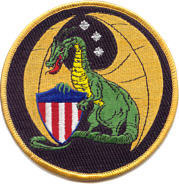
These patches have not been definitively identified with a specific launch, but considering that the number of stars depicted in other patches often correlates with the number of satellites of the type that have been launched, it seems reasonable to conclude that these patches depict the third and fourth launches of these satellites, then known as Aquacade, in 1977 and 1978.
Two mysteries remain, one probably meaningless and the other much more curious. The B-36 dragon patch has a starfield containing fourteen stars. Does this symbolize anything other than the American flag? The number does not match with anything that independent observers have been able to determine about these types of satellites, and it could simply be artistic license.
The more intriguing question concerns the dragon patch for what was probably the fourth satellite of this type launched into space, in April 1978. The patch features two streaks rising up from the Earth, one culminating in a star that undoubtedly represents the payload. But the other streak leaves the patch’s frame entirely. Does this represent a secondary payload that was boosted into an even higher orbit?
There is also another singular example from a different signals intelligence program known as Mercury. On June 24, 1996, Titan 4 K-16, named “Sweet 16” on its rocket patch, launched into orbit carrying what independent observers determined was a signals intelligence satellite. Independent observers have determined that the United States has long operated three different classes of high altitude signals intelligence satellites. They speculated that this was of a different class of payload than the Rhyolite type represented by the dragon (one major difference was that the Titan 4 used a different launch shroud). These satellites had originally started with the name Canyon and later versions had the names Chalet and Vortex and finally Mercury. The K-16 launch was the fourteenth launch with the characteristics of these satellites. Fourteen launches. Fourteen stars.
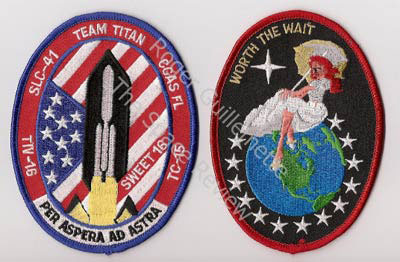
The patch featured a pretty girl sitting atop the world—a reference to a girl’s Sweet 16 party. But the girl was also holding a gold parasol. Erase the girl from the image, and the parasol forms an umbrella shape similar to the large dish antennas that independent observers believe is used by signals intelligence satellites—and coincidentally, similar to the golden “dragon wings” on the B-25 payload patch.
Continue reading part two
Article from: http://www.thespacereview.com/article/1033/1
